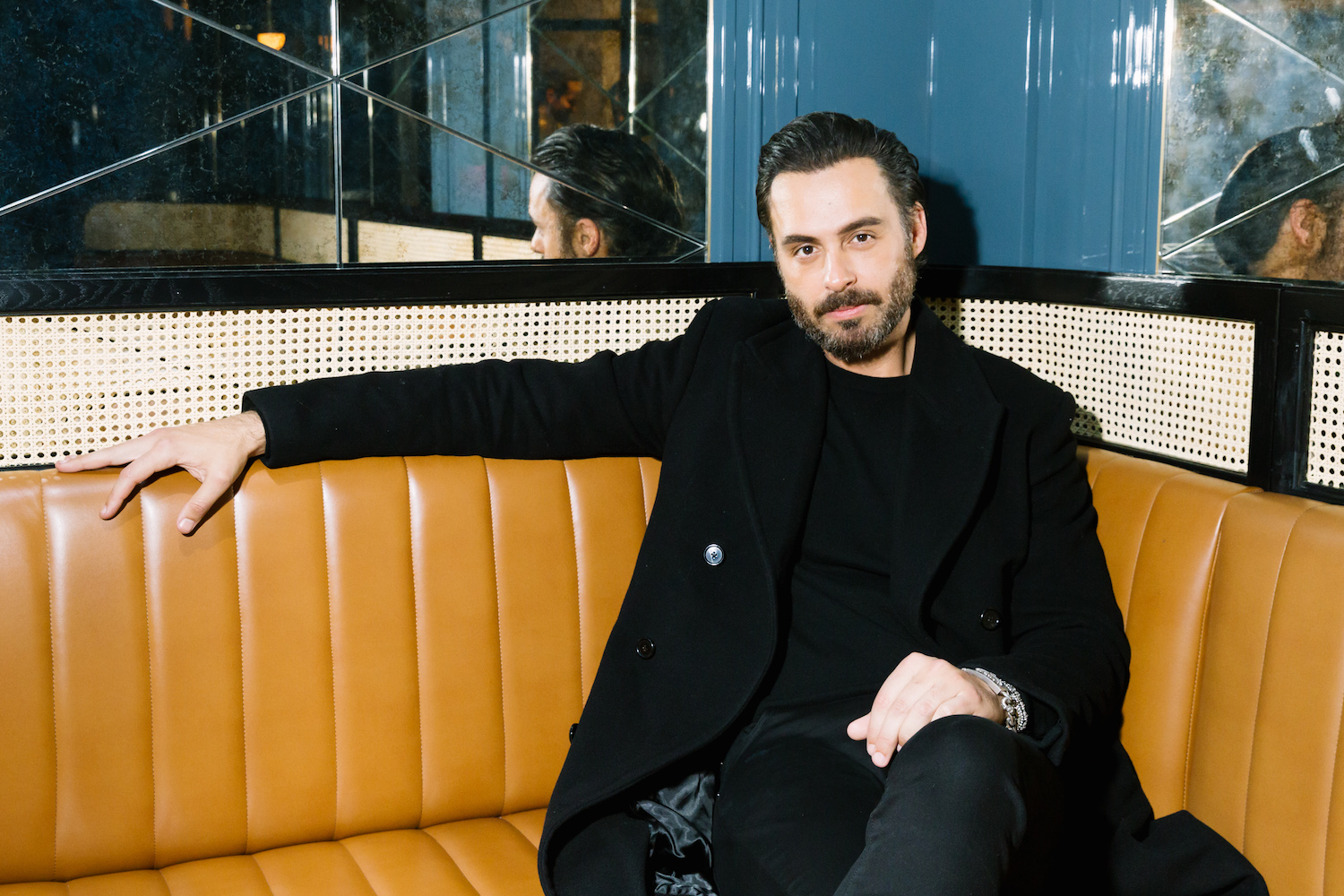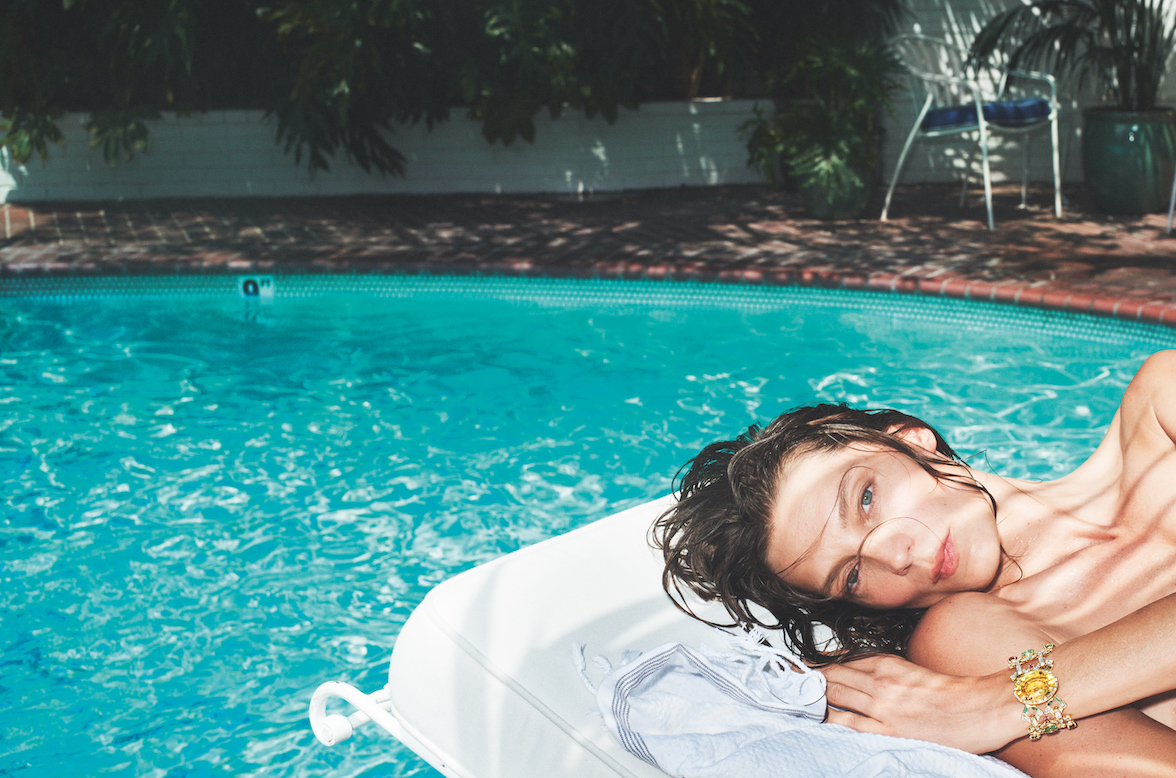In the past three collections for Pyer Moss, Kerby Jean-Raymond has shed light on the role of Black people in American pop culture. From the legend of cowboys to rock and roll, whether forgotten or intentionally erased, the trilogy of shows dubbed “American, Also” retells the story of Black creativity and impact. By way of fashion, Jean-Raymond is on a mission to empower his community—locally in Brooklyn and broadly to Black people.
Working in the same borough of New York, photographer Delphine Diallo is intent on changing the perception of the Black female body. Through her studies of anthropology and mythology, she produces powerful portraits and collages that express the divine feminine energy. She’s challenging the Black woman archetype created by the white male gaze and Western patriarchal societies.
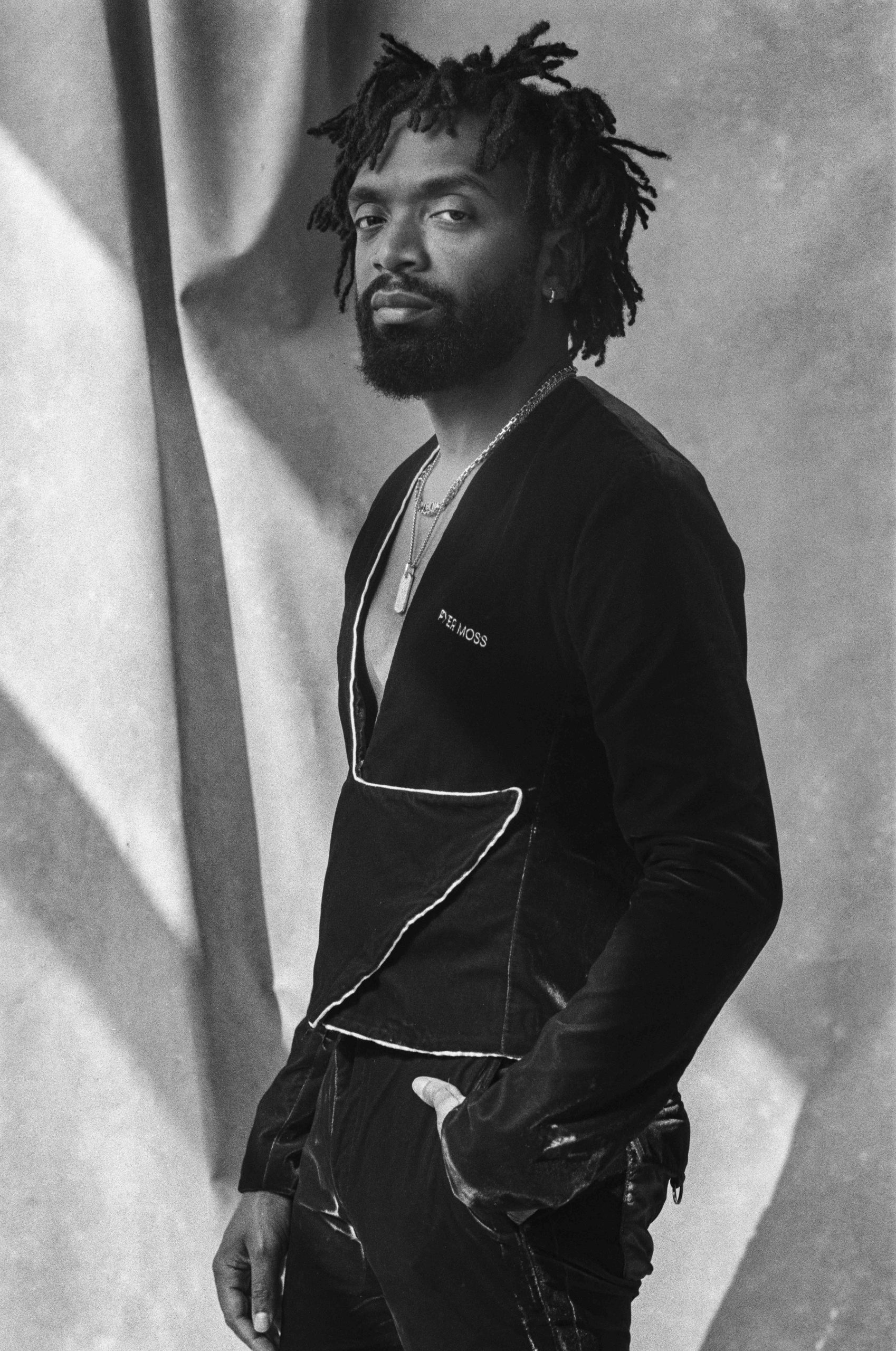
KERBY JEAN-RAYMOND IN SEAN JOHN BY PYER MOSS SUIT, PHOTO BY DELPHINE DIALLO.
In August, Diallo invited Jean-Raymond to her studio in Bushwick. After she took his portrait, the pair sat down to talk, driven by a desire to reclaim the narrative of Black consciousness and contributions. Their conversation moved from the personal, to the professional, to the public.
KERBY JEAN-RAYMOND: How are you doing?
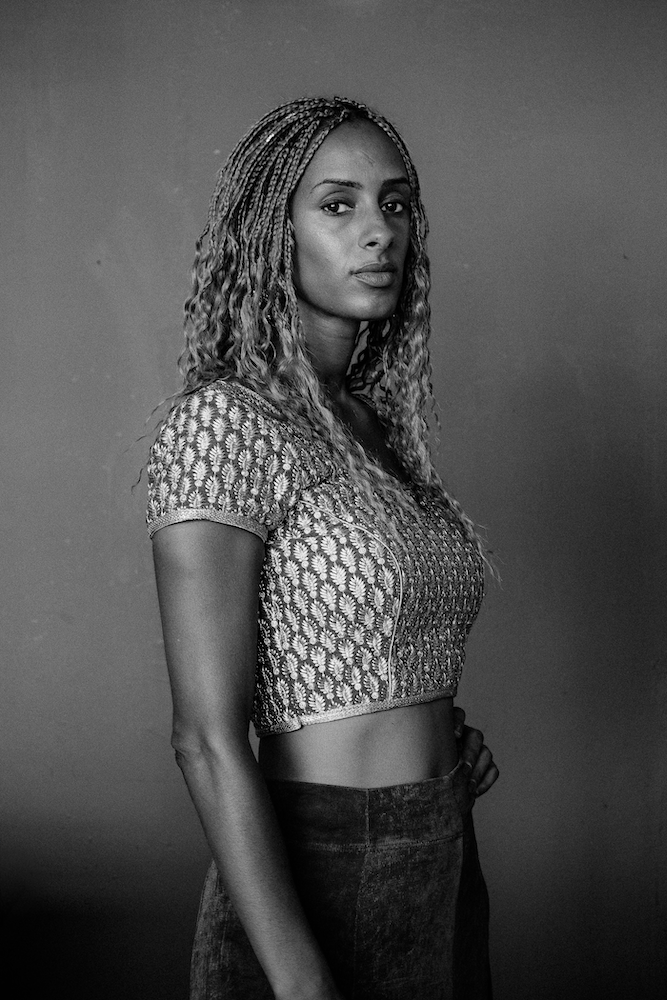
Delphine Diallo, portrait by Haruka Sakaguchi.
DELPHINE DIALLO: I’m good.
KJR: How do you feel? If you had to describe your range of emotions in three words, what would they be?
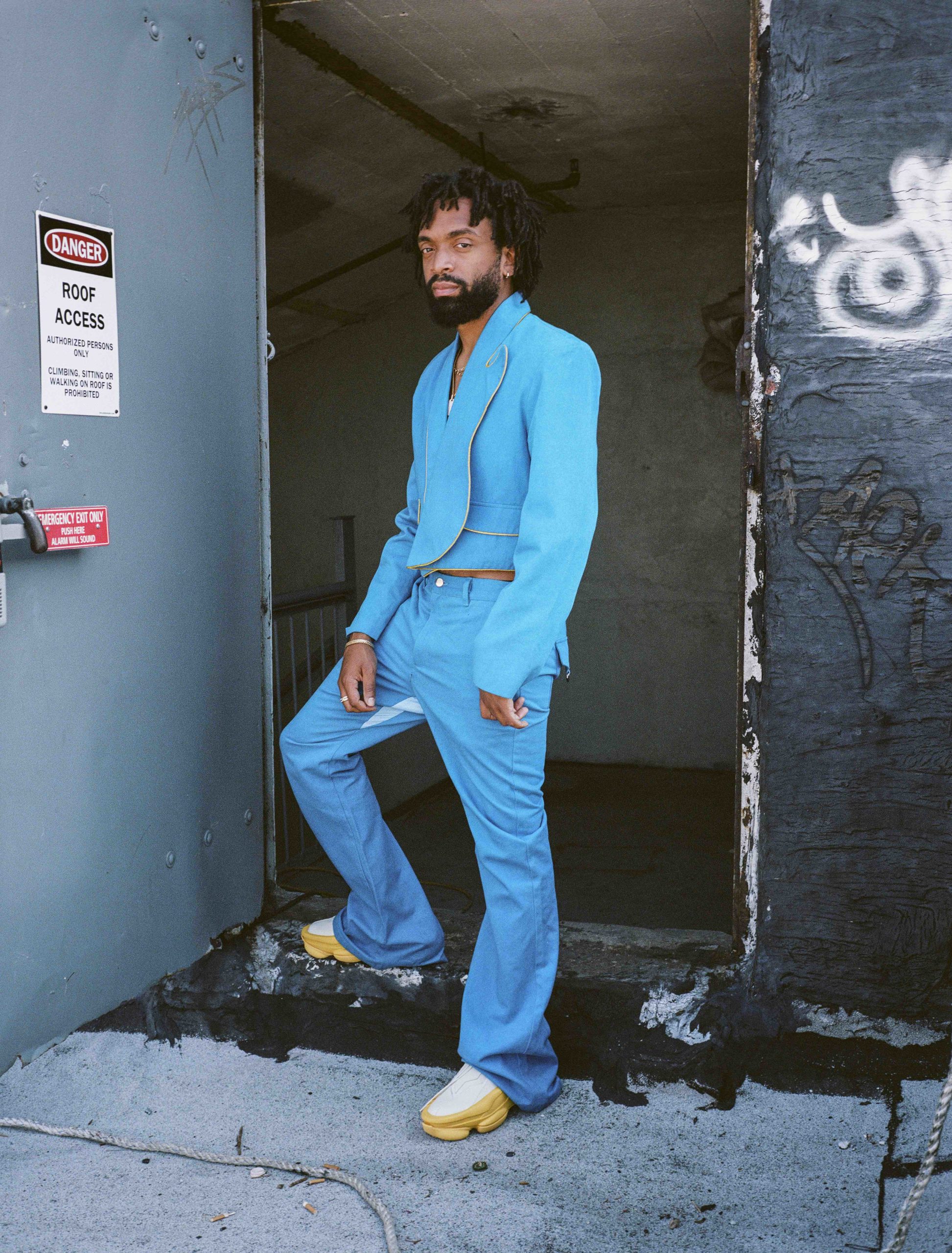
Kerby Jean-Raymond in Pyer Moss Cropped Guitar Suit, photo by Delphine Diallo.
DD: Abundant, integrity, and love.
KJR: How does that correspond to how the past few months of quarantine have treated you?
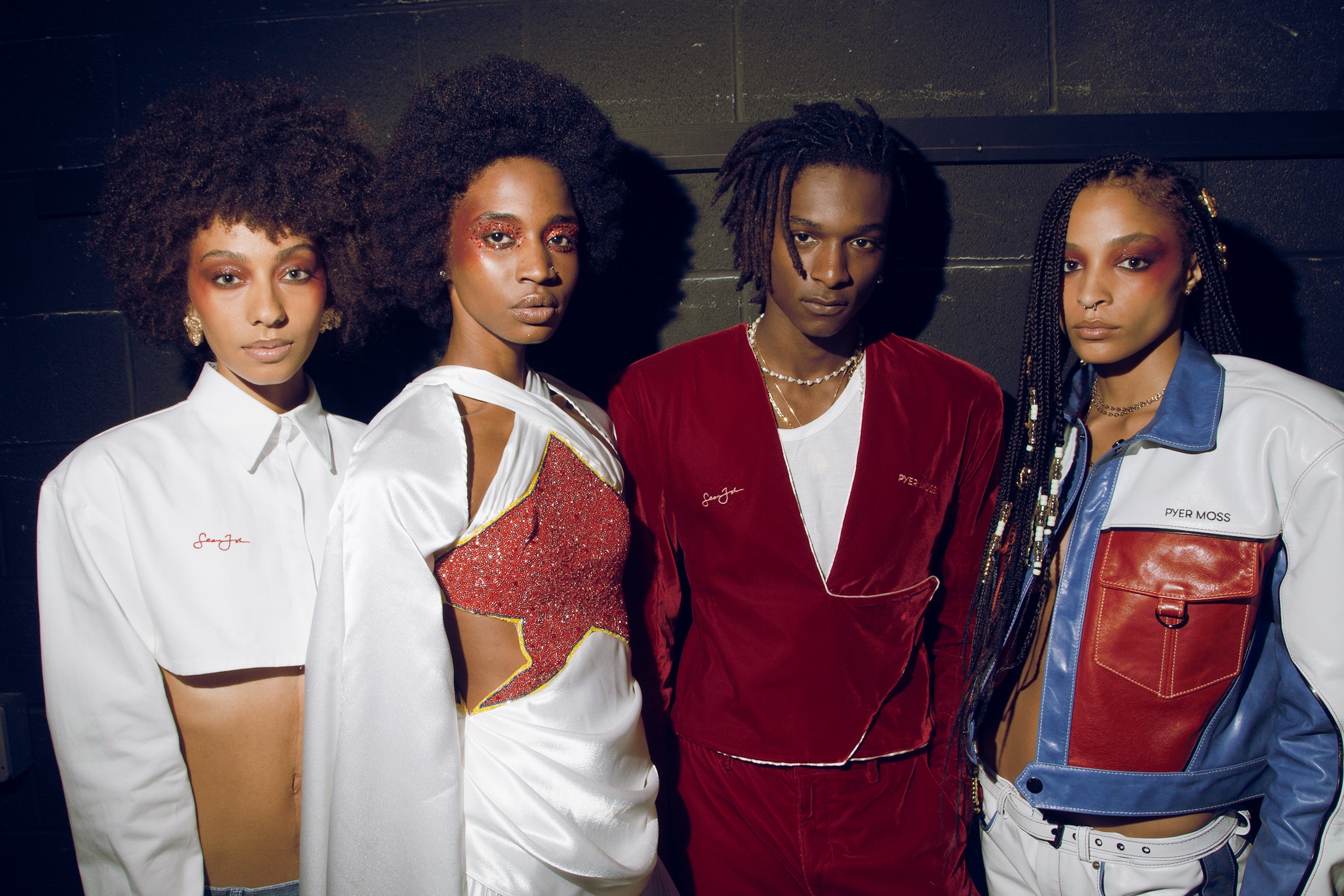
Pyer Moss Collection 3, photo by Denzel Golatt.
DD: They were very challenging. We had to change the way we perceive the world. So I did the work to focus on taking care of my friends, my family, and it gave me a sense of connectedness.
KJR: I think the want to be with people is a lot stronger, so when you do spend that time it’s a lot more effective.
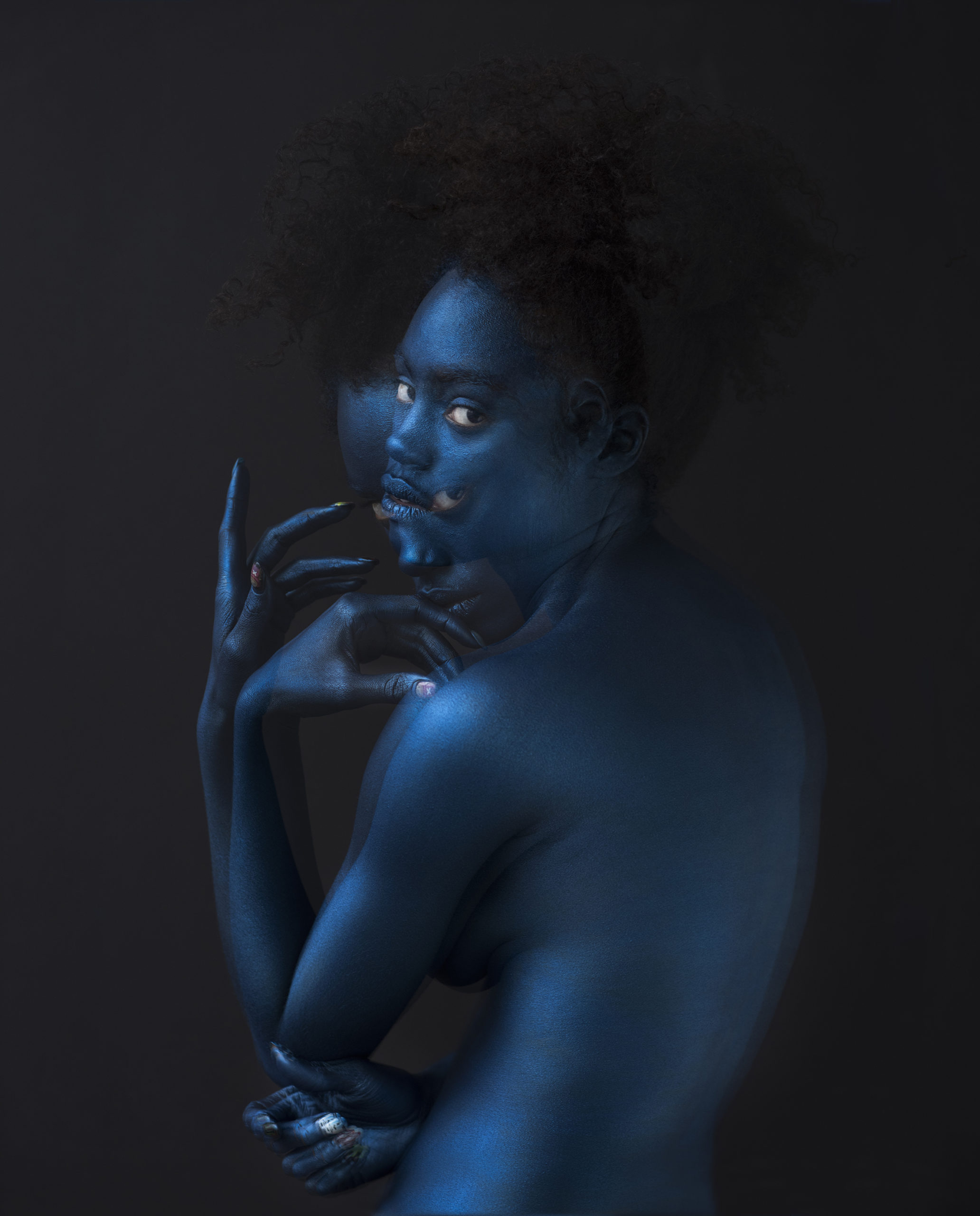
Delphine Diallo, “Shiva,” 2018, courtesy of the artist.
DD: Now when I share a moment with a friend, I’m even more present.
KJR: I noticed that with me, with hanging out with my dad. I used to always be in a rush to go. Now, I’ll hang out with him the whole day. Or when I go to my family’s houses now, I stay the whole day. Because you have to go through this whole mental process of getting out of the house because of the fear of everything around you. You have to put on a mask, worry about who has COVID. You pick your people.
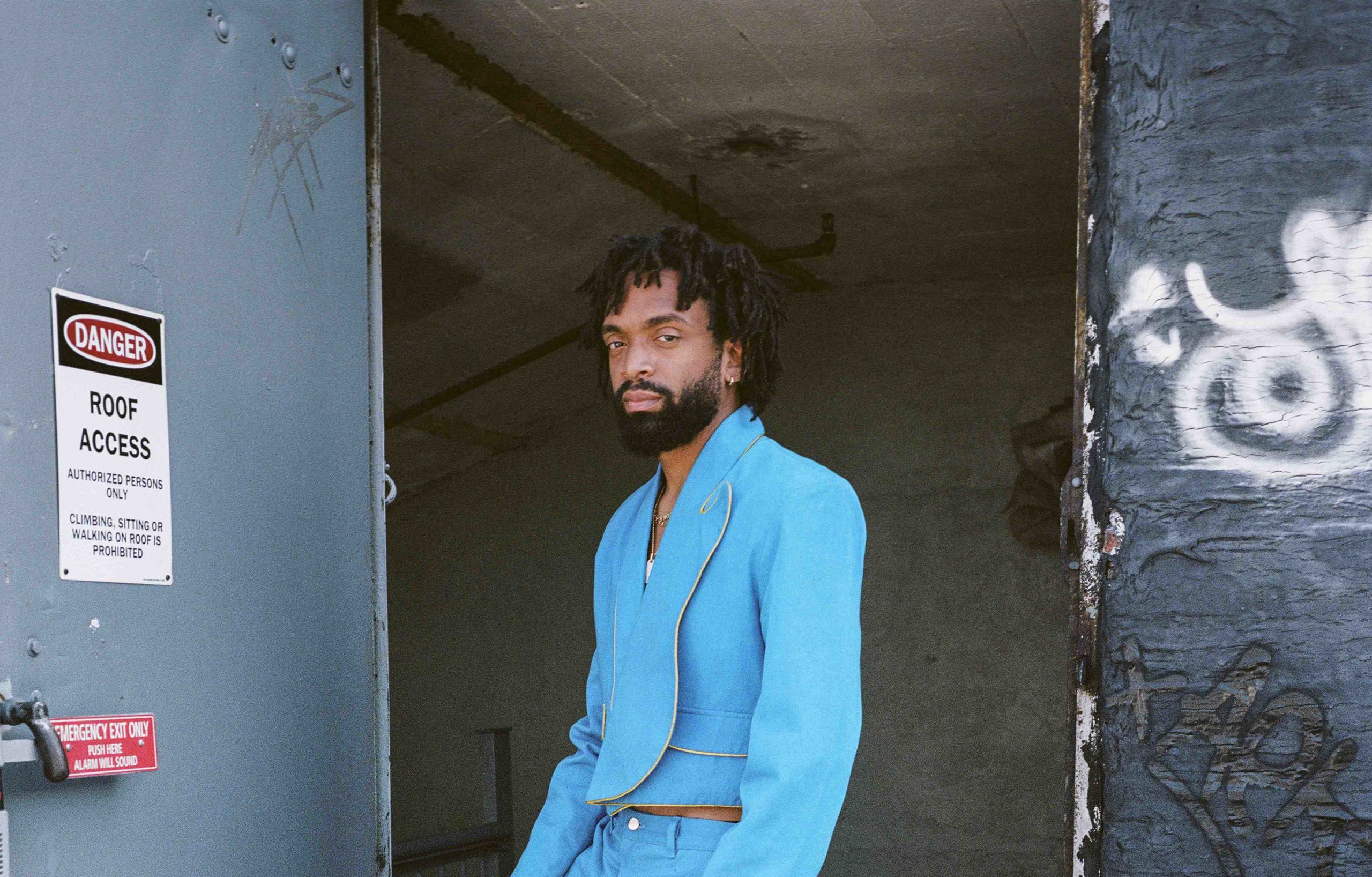
DD: Coronavirus gave me more self-confidence. Because I need to choose my reality.
KJR: I moved into my first house in Brooklyn during quarantine. Prior to that, I’d never lived in bigger than a one-bedroom my whole life. Until after college, I’d never had my own room. So now I have a lot of space and I have found myself filling it up with things, but I’m still not fully comfortable.
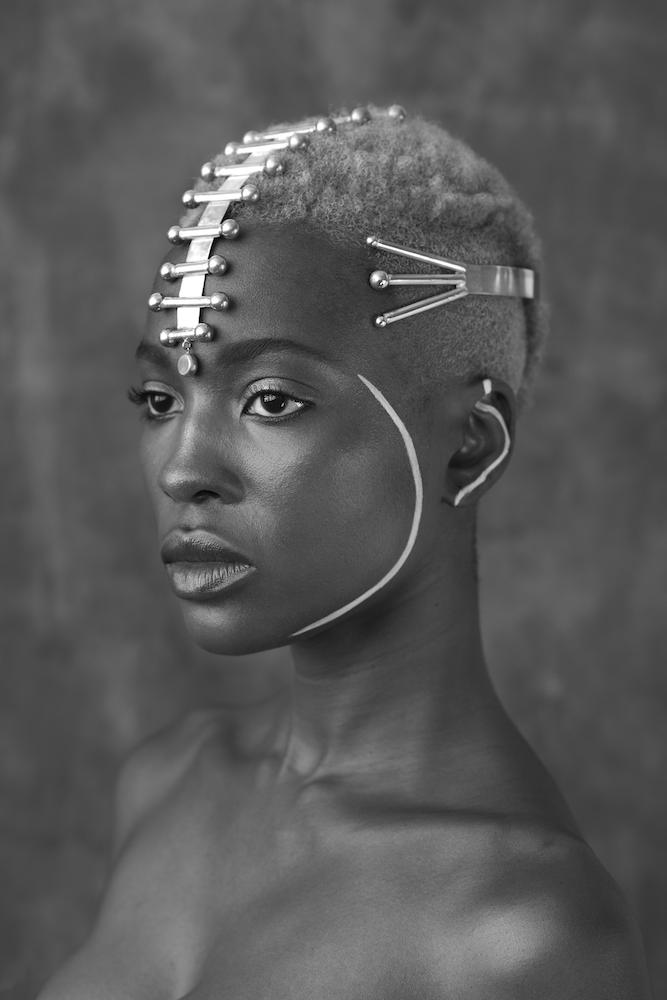
Delphine Diallo, “Cosmic Soleita,” 2017 (Amodaos), courtesy of the artist.
It feels like I’m creating a vision of home, but I haven’t created a home. What I noticed recently, having even a few people over, that’s what it was. That’s what home for me was; it’s this hub where all of my love can come in and out. And my love is people. Not having those people—it’s just a box with furniture.
DD: I love when my friends come here. That makes me feel at home.
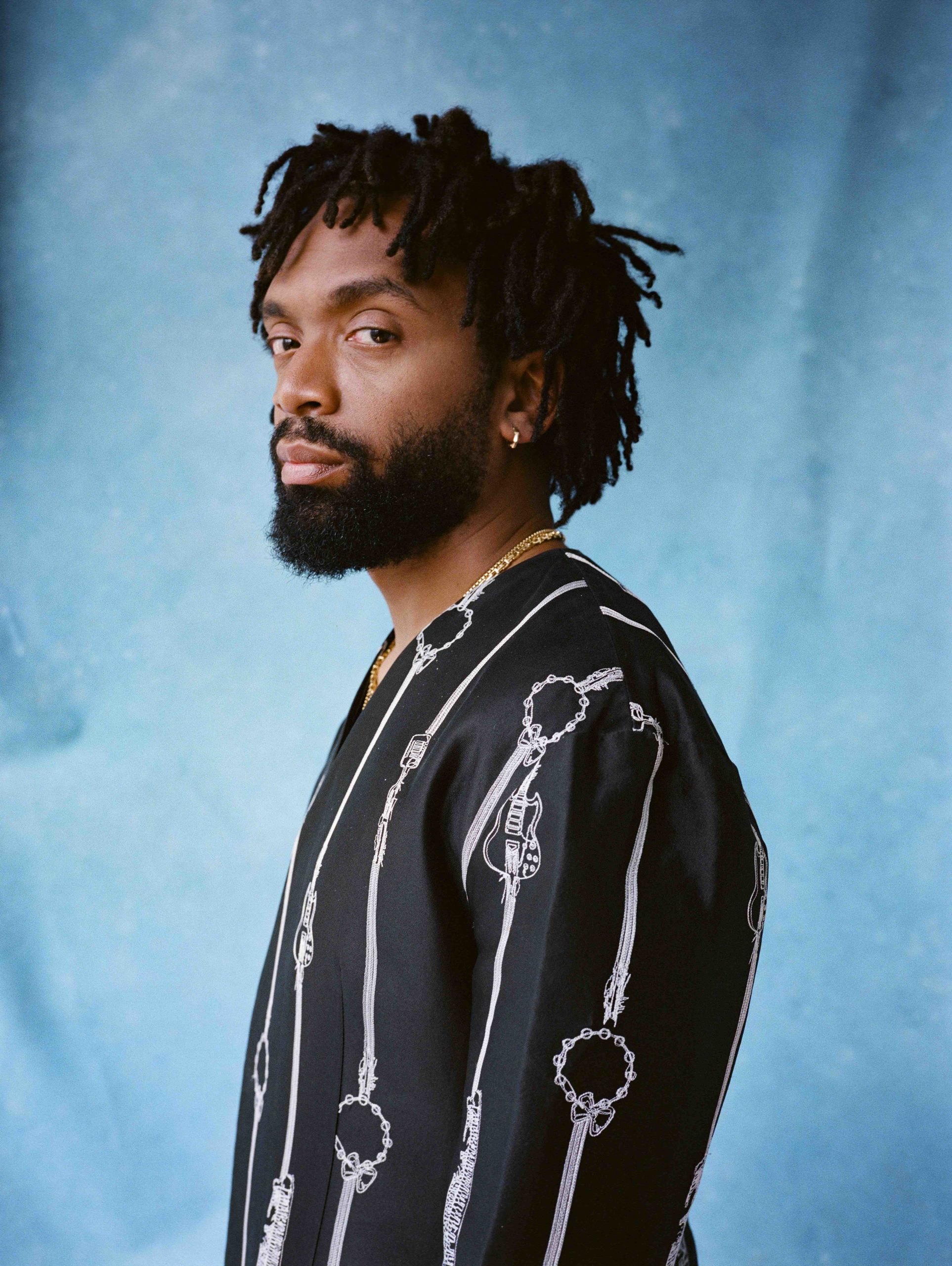
Kerby Jean-Raymond in Pyer Moss Instrument Stripe Zoot Suit, photo by Delphine Diallo.
KJR: What else would you consider home—metaphysically?
DD: I’m home everywhere. I’m a photographer because I don’t like routine. I am born for change and to feel connected with the world. Hopefully, before I leave this body, I will be able to experience it fully.
Photography facilitates that. I would have never met you if I didn’t take pictures. Photography allows me to enter new worlds, new dimensions, where I don’t really judge. I’m an extrovert experiencing.
KJR: I’m an introverted extrovert.
DD: I’m an introvert when I’m working. I can not see people for seven to ten days when I’m working.
KJR: You know, what I learned about myself in quarantine is that our body is a proximity center.
DD: What does that mean?
KJR: When everything was open, I would go to so many things. I would go to the office, I would go to the parties, I would go to the dinners, and I wasn’t curating my space. I was a victim of my circumstance. My circumstance is who I am in this world, being invited to a lot of things and not being necessarily selective.
And in this process, I’ve had to select who comes into my life. What I’ve noticed is that my body knows how to tell me when there’s danger and it shows up in forms of anxiety. I didn’t know it before because I was moving so fast. I was just moving from one emotion to another, so I didn’t get to process it. I shouldn’t be moving at this pace. I should slow it down. And my body has been trying to tell me, but I wasn’t moving slow enough to pay attention. Finally, I’m figuring that part out.
DD: It gave you more understanding of your inner essence and emotions, and how you’re going to be able to grow as a successful person. We have a feeling of wanting to master something here. This body has been given to me, this brain, and I want to know every day a little bit more. I have no idea how much I can give.
We have been living under a past which is so heavy. We have something in mind, but it’s so vast that it’s overwhelming. I can’t perceive it yet.
KJR: I think what’s happening now is this great liberation, this mental enlightenment period. We had the Harlem Renaissance, you have the Civil Rights era, and there’s one happening now. It’s a new age of enlightenment. Disenfranchised people are starting to understand their full potential. The next round is actually executing on it. What’s that world going to look like when the sympathetic people rule it?
DD: We lead. My mission is the narrative of the feminine energy within the body of Black women, who are going to bring a different love. It’s like a sunset and a sunrise every day, that’s what the feminine energy is. It’s all about the vision of Black women not being judged anymore and perceived as an object. And for Black men, for me, it’s that we don’t know you guys. Why? Because I didn’t make the effort.
KJR: Yeah. Do you feel like the tides are changing now, with our representation in the art space?
DD: Yes.
KJR: I do, too.
DD: But it’s a baby.
KJR: It’s an aggressive baby.
DD: Everybody wants it. I have a lot of requests. The abundance is going to come. And I better know what I’m going to do.
That’s why I’m doing this work. I’m a spiritual warrior. The shift in the industry won’t be a good shift if the people creating the vision are not intending to change the white male gaze based on colonization, slavery, and identifying human beings to separate them.
KJR: Control them.
DD: They want you to lose power. They don’t want you to believe in yourself. They want you to spend money, have a job, but believing in yourself is gone. And the Black generation now, it’s like, we can create.
KJR: Do you feel like capitalism is necessary to save Black people?
DD: There is a need for Black luxury. Why are we complaining about Vogue putting one woman on the cover or not? Why do we need them?
KJR: We don’t need them.
DD: If you’re putting the abundance within the Black creatives, then what kind of capitalism or what kind of structure and wealth and richness are we going to create? This is where the mind needs to be in educating the African diaspora. That’s the first mission.
KJR: We can’t ignore that right now we have to use capitalism as a tool to liberate ourselves. So much of what is oppressing us is the lack of financial freedom.
I’m from here, I’m from East Flatbush, Brooklyn. My neighborhood used to be all-white. When Black people moved in the seventies and eighties, all the white people left. And we were still stuck with a lot of the same resources they had from the fifties, sixties, seventies— dilapidated buildings, old textbooks, very little community resources, no real sustainable afterschool programs.
I worry about communities like mine where the resources were stripped away once Black people moved in and how these people had to make do. So I use everything in me and in my power to bring the traffic back home. I go out in the world and I collect things—I collect people, I collect resources, I collect money, I collect knowledge—whatever I need to do, and my intention is always to spread it back home. Not just Brooklyn, not just New York; it’s all of us, all Black people. All Black people need this.
That perpetual rut where we feel like we’re being defeated—that doesn’t have to be. We’re going to overcome it by having more and more examples of us showing ourselves that we’re viable and that we’re worth each other’s time.
DD: What inspires you?
KJR: I would say things that lead me to create revolve around some things that are dark. Sometimes it’s trauma, sometimes it’s distrust, sometimes it’s a need to protect my people. For my last three shows, I’ve done things that reacclimate Black people into the American conscience of pop culture by showing them their contributions. I showed their contributions to cowboy culture, what Black familial structures looks like, and what the birth of rock and roll looks like. But I’ve also done collections about depression, capitalism, and around my dad.
I’m regurgitating a roadmap. Whatever roadmap I saw, whatever thing I had to follow to get through something, I bring it back and show it in very multidimensional ways. I look at fashion more like a canvas. My canvas might change, and it might become film and sculpture. Right now, this was the thing that came naturally to me; it was innate. My first clothing lines when I was a teenager were trying to do the same thing I do now, which is communicate a message. Like graphic tees that would talk about the Iraq War and how I felt about 9/11.
Now I feel like something doesn’t feel innocent about the work and about the way I’m expected to present the work, so I’ve been taking a lot of time off. I’ve been quiet for a minute. At this point it’s been a year since I’ve shown anything new. And it will probably be another year before I do. I just want to take my time with it. I don’t want to play on the fashion schedule.
DD: I think it’s about time.
KJR: Our job as artists is to translate the times. We can’t translate what we don’t live. I need to see what this world becomes before I give you any work.
DD: Especially now. The narrative I’m exploring is the position and role of the Black woman in this world, within a body that is disrespected. I’m putting forth a different kind of beauty. My goal is to make it universal, to change the narrative and hopefully have other young female photographers shift the perception. We have the power and the vision. This is our right. This is the only way we can create equality in society. The diaspora will completely change the narrative.
KJR: We’ve always spoken about race. We wanted this to be a canvas so we can do cool ideas and talk about things we love. We discovered a whole underbelly of this industry that’s very racist and elitist. And because of that, we’ve always taken the initiative to lead the way. This is how you should help Black people; this is how you should speak to Black people. Now we are in this position where everyone is finally doing it and it’s enough for us to sit back and say, you know what we stand for, we don’t have to put up a black square. We don’t need to do a performative act. We’ve never stopped being that.
This period has given me a much-needed break and understanding of personal energy and spirituality. I started to realize there were a lot of things I wasn’t over.
DD: In terms of trauma? You still have anger?
KJR: I’m still trying to deal with things from seven years old, things from thirty years old, relationships. I have this amazing talent where I can get out of a relationship and completely forget that person existed. But this thing, this period, has forced me to reconcile all of these different things.
DD: It’s come back to you.
KJR: I just had a delayed response. I kept busy.
DD: So how do you relate to the present?
KJR: I’m catching up to the present. I can’t say I fully relate to the present yet. I’m learning to be present, to be in every room, actually. To get out of my head a little bit, to have more conversations, more dialogue, call people on their birthdays. I’m trying to be a little bit more human. I think I’d become this machine that was putting out good work, but eventually that well was going to run dry. I needed to recharge it. And I had to live again.
DD: There’s been an acceleration of fast life because of this phone, and we’re not able to process it. You became someone else, but you didn’t catch up, because you didn’t realize your consciousness was speeding up. You’re allowed to deal with, text with, 30 people at the same time. That increases your anxiety. You don’t have time for building a love relationship.
During COVID, my intention was to build a love relationship. The beauty of this year for me is to stop judging Black men for not reconciling seeing Black women as a sexual object. We both have pain and we can heal together. That will increase our ability to be present for the community.
KJR: I don’t think up until now I was ever mature enough to be honest with Black women about my traumas and the toxic guards I put up to protect them. All of my relationships with Black women ended the exact same way. It always ended with them feeling defeated in my ability to grow. And me subsequently feeling like their intention was to mother me. I think ultimately this is a really great time, this is a blessing.
DD: Your reaction and the reaction of my man was the same. He compared me to his sister. And I was like, “I’m not your sister. Let’s talk about it.” He saw I admitted my flaws and then he opened a door. That new door is forgiveness for past trauma.
I had to forgive my dad to be with a Black man. It’s a repetition. The oppression that my dad experienced is the pain I received as a kid. His was a lonely, isolating battle within the white world. Once I understood that, I understood that I needed to forgive. And my dad saw that I forgave, so he changed.
KJR: Do you forgive yourself for not understanding?
DD: I forgive myself for taking all that time. But knowledge and truth came to me, and I’m blessed it came to me in this life, because it allowed my karma to change. I don’t hold grudges and anger anymore. I have no space for that.
KJR: The biggest breakthrough I had was I forgave my father during this process. I never knew how. I found out how now. All of it makes sense now and I had to forgive him. I had to reason with him without him knowing I reasoned with him. I had to forgive myself and him. And now I have this backlog of all the other stuff I need to go through. I’m going to catch up, but I need this time.
Photographs by Delphine Diallo
Grooming by Nigella Miller
Assisted by Emily Charlaff






